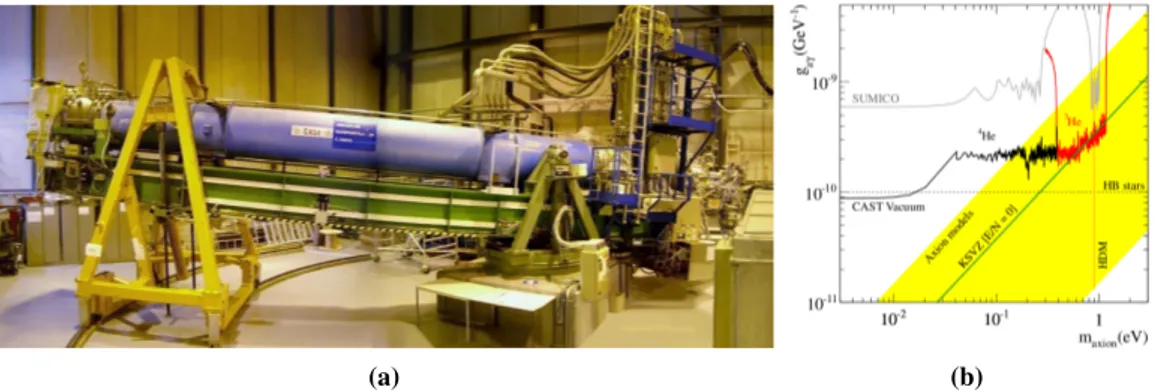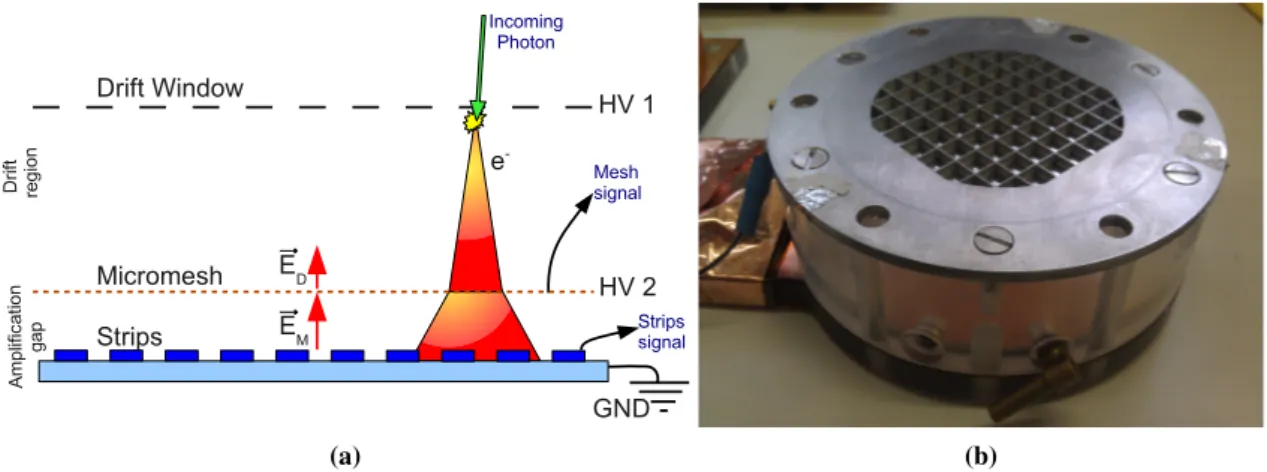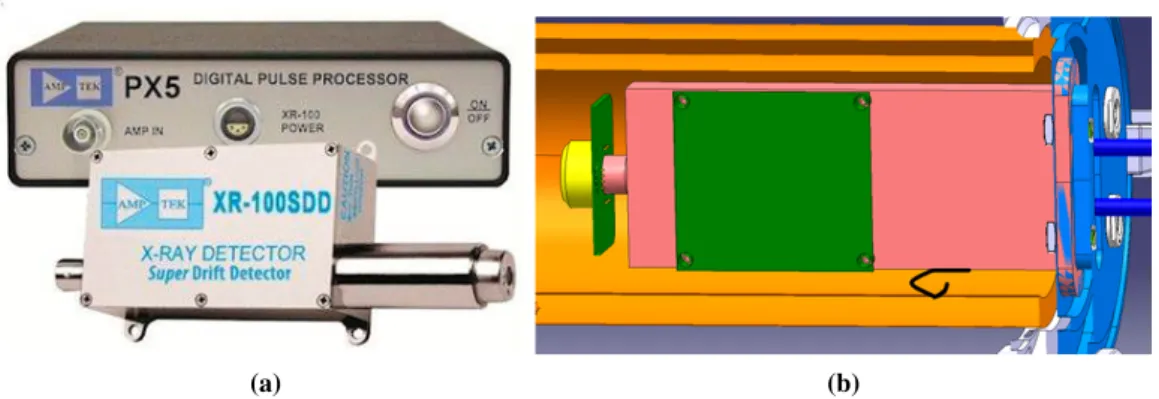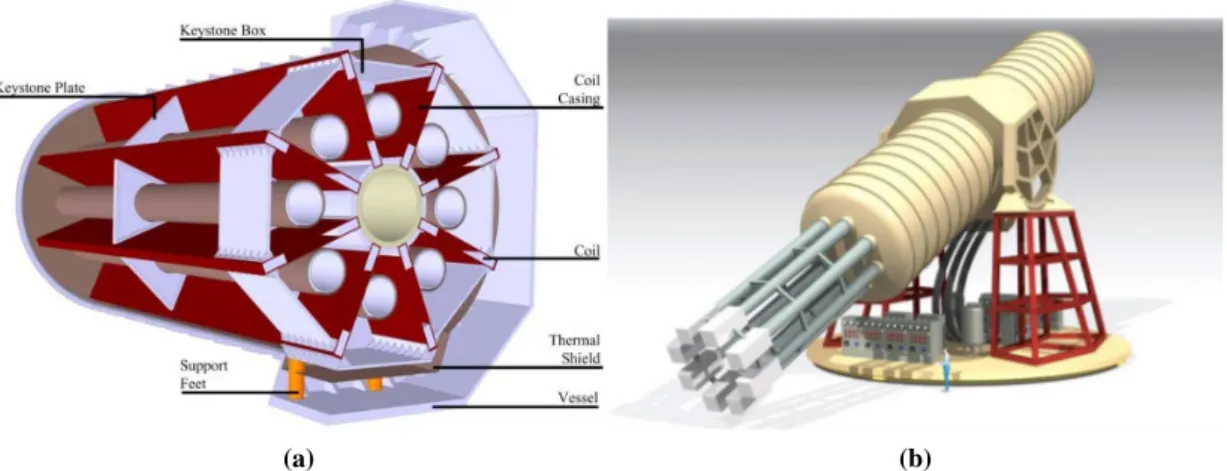This content has been downloaded from IOPscience. Please scroll down to see the full text.
Download details:
IP Address: 212.174.144.130
This content was downloaded on 15/07/2015 at 07:21
Please note that terms and conditions apply.
X-ray detectors of the CAST experiment
View the table of contents for this issue, or go to the journal homepage for more 2014 JINST 9 C03047
(http://iopscience.iop.org/1748-0221/9/03/C03047)
2014 JINST 9 C03047
PUBLISHED BYIOP PUBLISHING FORSISSAMEDIALAB
RECEIVED: November 30, 2013 REVISED: January 17, 2014 ACCEPTED: January 24, 2014 PUBLISHED: March 25, 2014
13th TOPICAL SEMINAR ONINNOVATIVEPARTICLE ANDRADIATION DETECTORS
7–10 OCTOBER 2013
SIENA, ITALY
X-ray detectors of the CAST experiment
S.C. Yildiz
Physics Department, Do˘gus¸ University, Zeamet Sok, Istanbul, Turkey
E-mail:cenk.yildiz@cern.ch
ABSTRACT: CERN Axion Solar Telescope (CAST) is an experiment probing hypothetical
parti-cles: the axions, created in the solar core. Inside the transverse magnetic field of the CAST magnet, axions can be converted into x-rays, and be detected by four x-ray detectors at CAST. The expected x-ray signal in CAST is in 1–10 keV range, intensity depending strongly on the coupling constant of axion-photon conversion gaγ, which is expected to be low. This requires CAST to have detectors
with very low background levels.
The CAST Experiment makes use of three Micromesh Gaseous Structure (micromegas) de-tectors, which are gaseous dede-tectors, derived from ideas of Multiwire Proportional Chambers (MWPC). CAST Micromegas detectors show perfect stability, good spatial and energy resolution. The intense study on Micromegas has enabled CAST to understand the nature of its background level, and improve it by a factor of 102 over ten years. New detector design, new readout system, better cosmic veto and addition of x-ray telescope will further improve the background in the next data taking of the experiment.
The Charge-Coupled Device (CCD) of CAST is a pn-CCD detector with 200 × 64 pixels. The CAST CCD is coupled to an X-ray telescope, focusing all the parallel x-rays into a 9 mm diameter spot. The CCD will be replaced by the InGrid detector, a special manufactured micromegas de-tector. It is able to detect single electrons, and the low energy capabilities will open new frontiers on search of axions and other exotic particles. Another option is the Silicon Drift Detector (SDD), which is being tested in 2013, and has an energy threshold as low as 250 eV.
The CAST experiment is the pioneering helioscope that excludes an important part of axion mass-coupling constant parameter space, and expects to exclude more in the following years. To succeed CAST, a new experiment, the International AXion Observatory (IAXO) is being designed and optimised, comprising the construction of a magnet specially built for axion search as well as new detectors that will enable to improve the actual limits by 1–1.5 orders of magnitude.
KEYWORDS: Micropattern gaseous detectors (MSGC, GEM, THGEM, RETHGEM, MHSP,
MICROPIC, MICROMEGAS, InGrid, etc); Dark Matter detectors (WIMPs, axions, etc.)
2014 JINST 9 C03047
Contents
1 The CAST experiment 1
2 X-ray detectors of CAST 2
2.1 CCD and the X-ray telescope 2
2.2 Micromegas 3
3 Evolution of the CAST micromegas 4
4 New detectors of CAST 5
4.1 Silicon Drift Detector 5
4.2 InGrid 5
5 IAXO — Future of solar axion search 6
1 The CAST experiment
The axion is pseudo-scalar Nambu-Goldstone boson of the Peccei-Quinn Symmetry, which is pro-posed as a solution to so called Strong CP Problem [1]. It is a hypothetical, neutral, light and very weakly interacting particle, and is a possible dark matter candidate due to its weakly interacting nature. Although it may have coupling to different particles depending on the model, the most widely accepted coupling is the Primakoff conversion, where axion couples to two photons. The Primakoff effect consists of axions and photons being converted into each other with the same probability while passing through a transverse electric or magnetic field [2,3]. The coupling con-stant of this process gaγ, and the axion mass ma are the unknown parameters of the axion models
and there are cosmological and astronomical limits that define boundaries of these parameters [4]. The Primakoff effect can take place in the solar core in the electric field of atoms, as blackbody x-ray photons are converted into axions, which have an energy spectrum in the soft x-ray range, and can escape from the sun without further interaction. One way of detecting solar axions is the helioscope technique, which uses strong magnets aiming to convert axions back into x-rays and detect the converted photons with x-rays detectors [5].
CERN Axion Solar Telescope (CAST) is the leading helioscope in axion search and is located at CERN. It uses a prototype superconducting LHC dipole magnet with 9.26 m of length, 8.8 T magnetic field, operating at 1.8 K. It has two cold bores of diameter 2.15 cm, and in both ends of each bore, there are x-ray detectors. The magnet is installed on a support system, which is built on a movable platform that can rotate ±8◦ vertically and ∼ 90◦ horizontally. The magnet movement system can track the sun for total of 3 hours during sunrise and sunset, where the detectors on the opposite sides of the magnet are sensitive to axions depending on the time of the day. A photo of the CAST magnet and its movement system can be seen in figure1a, while detailed description of the setup can be found in [6].
2014 JINST 9 C03047
(a) (b)
Figure 1. (a) The photo of the CAST magnet. (b) The exclusion plot produced from the result of CAST, including all detectors until 2009, and three micromegas detectors between 2009-2012.
CAST has run in two phases: the vacuum phase between 2003–2004 where it was sensitive to axions with masses lower than 0.02 eV, and the gas phase between 2005–2012, where it extended its sensitivity to axions with masses less than 1.1 eV. The results of CAST have been published in references: [7–10], and combined results are presented in figure1b.
2 X-ray detectors of CAST
The sensitivity of helioscopes depend on magnet properties (length, field strength, solar tracking ex-posure time) and detector properties (background level, efficiency). Rare event searches like CAST require very low background levels, and at CAST several techniques were used to provide this:
• passive/active shielding • X-ray telescopes
• offline analysis techniques • using radiopure materials. 2.1 CCD and the X-ray telescope
CAST CCD detector is installed on the sunrise side of the CAST magnet, sensitive to axions con-verted during the sunrise. It is a pn-type CCD, which was developed for XMM-Newton mis-sion [11], is fully depleted and 280 µm thick. It has a readout consisting of 200 × 64 pixels, each of which is 150 × 150 µm2, making an area of 2.88 cm2(figure2b).
It is coupled to an X-ray telescope (figure 2c) that is a grazing incident, Wolter I type [12] telescope, built originally for ABRIXAS mission [13]. The telescope has 27 concentric gold coated nickel shells, that can be parabolic or hyperbolic, diameters of which vary from 76 mm to 163 mm (figure2c). The focal length of the telescope is 1600 mm, focusing the parallel x-rays into 9 mm2 spot on the chip.
The focusing brings important advantages to CCD detector. The expected signal coming from 14.5 cm2 cold bore area, being focused to 9 mm2 spot, allows a further signal to background im-provement by a factor of 150, allowing the simultaneous measurement of signal and background at
2014 JINST 9 C03047
(a) (b) (c)
Figure 2. (a) The photo of the X-ray telescope and pn-CCD detector. (b) The CCD chip. (c) X-ray telescope of CAST. Strips Micromesh HV 1 HV 2 e -ED E M D rif t re gi on A m pl ifi ca tio n ga p Strips signal Drift Window Mesh signal Incoming Photon GND (a) (b)
Figure 3. (a) The working principle of micromegas. (b) Chamber of a micromegas detector, with its drift window on the top.
the same time, such that all hits outside the spot is considered as background. Furthermore in case of a strong axion signal, the axion emission image of the sun can be seen on the chip, thanks to its imaging capabilities.
2.2 Micromegas
Micro Mesh Gaseous Structure (Micromegas) was developed in 1995 and is being used in particle physics experiments increasingly [14]. It features a drift region, a micromesh with high electron transparency and one or two dimensional strip/pad readout below the mesh. In the recent detectors the drift region is 3 cm, while mesh and strips are separated by 50 µm, creating the amplification gap. The electrons created in the drift region travel to the mesh, and pass to the amplification gap due to the high transparency, and are amplified with the high electric field. The micromesh captures the ions that are created in the amplification gap, while strips collect the electrons, providing two separate readouts. A schematics of the operation principle can be seen in figure3a, while a photo of a micromegas chamber is shown in figure3b.
2014 JINST 9 C03047
(a) (b)
Figure 4. (a) The sunset micromegas detectors. (b) The sunrise micromegas detector.
CAST depends heavily on the performance of Micromegas detectors, as three of the four mag-net bores are equipped with them. Two are installed in the sunset side [6], that share the gas system, vacuum system, data acquisition and shielding, while the third micromegas is installed in the sun-rise side [15], near the beam line of CCD detector. Both systems are seen in figures4aand4b.
3 Evolution of the CAST micromegas
The micromegas production technique has been improved significantly during the operation of CAST. In the first detectors the strips and mesh were coupled using mechanical means, pushing them against each other and gluing, while newer technologies allow us to produce mesh and strips together by photolithography technique. Two important milestones in production technique are bulk [16] and microbulk [17] detectors and currently all CAST micromegas detectors are of the latest technology microbulk micromegas. The main improvement brought by microbulk detectors is better energy resolution due to a more uniform amplification gap, and hence a better background rejection capability. Furthermore the microbulk readouts are measured to have very low levels of radiopurity, making them ideal for rare event searches [18].
Together with the new manufacturing techniques, detailed Geant4 simulations and laboratory tests have helped CAST understand that the main source of background for unshielded detectors is the environmental gamma radiation [19], with a small contribution of cosmic muons. With this understanding, the main reduction of the background was provided by building an efficient shielding. Before 2012, the sunset micromegas was shielded with 2.5–5 cm lead in all directions other than the direction of the magnet pipe, with an inner copper layer covering the chambers. In 2012, the lead thickness was increased to 10 cm, extending longer in direction of the magnet. The inner copper shielding thickness was also increased from 0.5 cm to 1 cm, and the stainless steel vacuum pipe that is coupled to the chamber was replaced with a copper one. In addition, to tag events induced by muons, an active muon veto counter was installed and all these improvements has brought down the background levels from 8 · 10−6keV−1cm−2s−1 to 1.7 · 10−6keV−1cm−2s−1 for x-rays of 2–7 keV.
In 2013, while the sunset micromegas was only updated with a new and more efficient muon veto, the sunrise detector was completely redesigned. The detector chamber is designed to have the body made from copper and teflon, compared to less radiopure materials in the previous microbulk detector set-up. The new detector also features field shapers to provide more uniform electric field.
2014 JINST 9 C03047
The readout electronics were also renewed in 2013, and instead of the gassiplex chip, AFTERchip together with T2K electronics were adapted to CAST micromegas [20,21]. The new elec-tronics provide the time evolution of each strip separately causing a better rejection. Combined effect of all the improvements brings the background levels below ·10−6keV−1cm−2s−1 for the first time at CAST.
In 2014, the sunrise micromegas will be upgraded with an x-ray telescope, decreasing the background to the ultra low levels, while maintaining the efficiency at CAST Range of Interest (ROI).
4 New detectors of CAST
The solar tracking capability and the high magnetic field of CAST make it a viable instrument to detect other solar exotica such as solar chameleons. Chameleon emerges from modified gravity models and is a possible particle candidate of the dark energy [22]. It can also be subject to Primakoff conversion, thus detectable by CAST. The main challenge in the chameleon search is that the energy spectrum of the converted photons peaks around 700 eV [23]. To probe chameleons together with solar axions, CAST will make use of two detectors in the following years.
4.1 Silicon Drift Detector
A commercial Silicon Drift Detector (SDD) from Amptek (figure5a) has been tested in the CAST Detector Laboratory [15]. The detector has a rectangular active area of 16 mm2, and energy thresh-old of 250 eV. It is coupled to the vacuum pipe with a Si3N4window coated with Aluminum, which
has transmission higher than 50% for 400 eV photons. The detector is cooled to 217 K with a Peltier cooling system and has an energy resolution of 2% FWHM at 5.96 keV. It features a Labview based data acquisition software, and acquires signals through its pulse processor PX5 [15].
After detailed test bench studies, the detector was installed at CAST in the place of CCD and the x-ray telescope and has been taking data during the sunrise solar trackings. With a compact lead shielding, it has a count rate of ∼ 2 mHz from 150 eV to 10 keV.
Parallel to the data taking with the commercial SDD, a new detector with bigger area is being prepared to be installed at CAST. The detector will replace the current SDD and has an area of 100 mm2, and it will be placed in a special vacuum vessel, with integrated signal connections and Peltier cooling system as seen in figure5b. Since the active area will be in vacuum, there is no need for window. Thanks to this, the energy threshold will be even lower, with increasing sensitivity due to the much bigger area. The new detector will make use of the PX5 and a modified version of the data acquisition system of the commercial SDD.
4.2 InGrid
InGrid is a novel detector produced for very low threshold applications [24]. It combines a silicon detector with the micromegas technique. In the anode of the detector, TimePix ASIC [25] that is made of 256 × 256 octagonal pads with 10 µm side length is placed, covering an area of 2 cm2[24]. The micromesh is built on top of the chip, aligning the mesh holes with the readout pads. To protect the chip against discharges, a resistive layer is deposited on the chip. The schematic drawing of the several layers is presented at figure6.
2014 JINST 9 C03047
(a) (b)
Figure 5. (a) Amptek XR-100SDD detector and PX5, (b) new SDD integrated in the custom made vacuum vessel.
Figure 6. The schematic drawing of InGrid detector readout.
The greatest advantage of the InGrid, is that avalanche from each primary electron is collected on a single pad and the energy of incoming events can be calculated from the number of primary electrons, instead of the total collected charge. Thanks to this technique the resolution at 5.96 keV can be as good as 11% FWHM, and the energy threshold is below 1 keV as required by the low energy search at CAST. A background level of 2.81 · 10−5keV−1cm−2s−1for 0–10 keV is reached in the laboratory test. Even though this value is higher than the micromegas detectors background level, the low energy capabilities makes it attractive for CAST. Furthermore, the InGrid detector is planned to be installed behind the X-ray telescope, that was used for the CCD. Together with the telescope and lead shielding, InGrid is expected to achieve very low background levels at CAST, while maintaining a low threshold.
5 IAXO — Future of solar axion search
CAST, having lead the solar axion search and excluding a large part of the axion mass-coupling constant parameter space, will soon finish its axion physics program. The detector improvements are already approaching the ultra-low background limit and all axion masses up to ma= 1.1 eV
2014 JINST 9 C03047
(a) (b)
Figure 7. (a) The IAXO magnet. (b) Concept drawing of IAXO Experiment.
The next big improvement in solar axion physics will be thanks to a dedicated magnet built for axion search. IAXO project [26] is designed with this philosopy and aims to become the next pioneering helioscope after CAST.
The IAXO experiment will feature a ATLAS like toroidal magnet, with eight bores at room temperature, each having 60 cm diameter, and 21 m length (figure7a). A magnetic field of 5.4T will be reached with such magnet and the movement system will be capable of 12 h of solar tracking each day. The concept drawing of the system is seen in figure7b.
The detector technology that will be used in IAXO will be based on microbulk micromegas and is already being tested at CAST. Each detector will be equipped with an x-ray telescope, bringing a further background reduction, aiming to reach the levels lower than ·10−7keV−1cm−2s−1.
With bigger magnet bores, longer tracking time, and lower background levels, IAXO expects to improve CAST limits by a factor of 20, entering deeper into uncovered part of the parameter space.
References
[1] R.D. Peccei, The strong CP problem and axions,Lect. Notes Phys.741 (2008) 3[hep-ph/0607268].
[2] H. Pirmakoff, Photoproduction of neutral mesons in nuclear electric fields and the mean life of the
neutral meson,Phys. Rev.81 (1951) 899.
[3] P. Sikivie, Experimental Tests of the Invisible Axion,Phys. Rev. Lett.51 (1983) 1415[Erratum ibid.
52 (1984) 695].
[4] G. Raffelt, Astrophysical Axion Bounds,Lect. Notes Phys.741 (2008) 51[hep-ph/0611350].
[5] K. van Bibber, P.M. McIntyre, D.E. Morris and G.G. Raffelt, A Practical Laboratory Detector for
Solar Axions,Phys. Rev.D 39 (1989) 2089.
[6] S.C. Yildiz, Search for Axions with Micromegas Detectors in the CERN CAST Experiment,
Ph.D. thesis, Bogazici University, Istanbul, Turkey (2013)CERN-THESIS-2013-205.
[7] CAST collaboration, K. Zioutas et al., First results from the CERN Axion Solar Telescope (CAST),
Phys. Rev. Lett.94 (2005) 121301[hep-ex/0411033].
2014 JINST 9 C03047
[8] CAST collaboration, S. Andriamonje et al., An improved limit on the axion-photon coupling from the
CAST experiment,JCAP04 (2007) 010[hep-ex/0702006].
[9] CAST collaboration, E. Arik et al., Probing eV-scale axions with CAST,JCAP02 (2009) 008
[arXiv:0810.4482].
[10] CAST collaboration, S. Aune et al., CAST search for sub-eV mass solar axions with 3He buffer gas,
Phys. Rev. Lett.107 (2011) 261302[arXiv:1106.3919].
[11] L. Str¨uder et al., The European Photon Imaging Camera on XMM-Newton: The pn-CCD camera,
Astron. Astrophys.365 (2001) L18.
[12] H. Wolter, Glancing Incidence Mirror Systems as Imaging Optics for X-rays in German,Annalen
Phys.445 (1952) 94.
[13] J. Altmann et al., Mirror System For The German X-Ray Satellite ABRIXAS: I. Flight Mirror
Fabrication, Integration, And Testing,Proc. SPIE3444 (1998) 350.
[14] Y. Giomataris, P. Rebourgeard, J.P. Robert and G. Charpak, MicrOMEGAs: A high granularity
position sensitive gaseous detector for high particle flux environments,Nucl. Instrum. Meth.A 376
(1996) 29.
[15] T. Vafeiadis, Contribution to Search on Solar Axion at the CAST Experiment, Ph.D. thesis, Aristotle
University, Thessaloniki, Greece (2012)CERN-THESIS-2012-349.
[16] I. Giomataris et al., MicrOMEGAs in a bulk,Nucl. Instrum. Meth.A 560 (2006) 405
[physics/0501003].
[17] S. Andriamonje et al., Development and performance of Microbulk MicrOMEGAs detectors,2010
JINST 5 P02001.
[18] S. Cebrian et al., Radiopurity of Micromegas readout planes,Astropart. Phys.34 (2011) 345.
[19] S. Aune et al., Low background x-ray detection with MicrOMEGAs for axion research,2014 JINST 9
P01001[arXiv:1310.3391].
[20] P. Baron et al., AFTER, an ASIC for the Readout of the Large T2K Time Projection Chambers,IEEE
Trans. Nucl. Sci.55 (2008) 1865.
[21] P. Baron et al., Architecture and Implementation of the Front-End Electronics of the Time Projection
Chambers in the T2K Experiment,IEEE Trans. Nucl. Sci.57 (2010) 406.
[22] J. Jaeckel and A. Ringwald, The Low-Energy Frontier of Particle PhysicsAnn. Rev. Nucl. Part. Sci.
60 (2010) 405.
[23] P. Brax, A. Lindner and K. Zioutas, Detection prospects for solar and terrestrial chameleons,Phys.
Rev.D 85 (2012) 043014[arXiv:1110.2583].
[24] C. Krieger, J. Kaminski and K. Desch, InGrid-based X-ray detector for low background searches,
Nucl. Instrum. Meth.A 729 (2013) 905.
[25] X. Llopart et al., Timepix, a 65k programmable pixel readout chip for arrival time, energy and/or
photon counting measurements,Nucl. Instrum. Meth.A 581 (2007) 485.
[26] I.G. Irastorza, The International Axion Observatory IAXO. Letter of Intent to the CERN SPS
committee,CERN-SPSC-2013-022.
[27] I.G. Irastorza et al., Towards a new generation axion helioscope,JCAP06 (2011) 013




